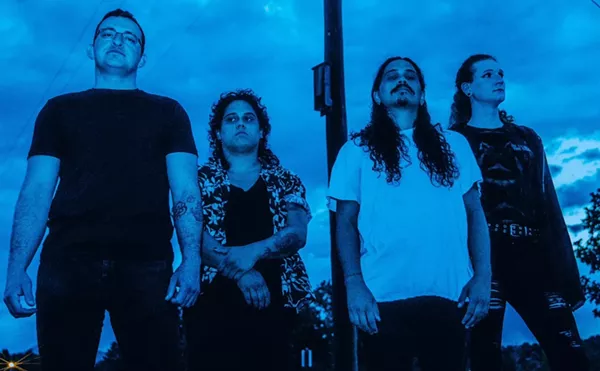Keeping track of metal and all its subgenres can often be confusing and frustrating. Classic and thrash metal are at the center of the metal universe, while various other styles are major and minor constellations radiating manic energy. Sorting through the subgenres can be a tedious task. This is why metal nerds were invented. Here we do our best to examine the ten most common metal subgenres.
See also: - The ten geekiest metal bands - The ten faceless metal bands - The ten horniest metal bands
10. Power Metal Power metal is more chipper than most metal subgenres, featuring a more exhilarated atmosphere with high-pitched vocals, a crisp recording, pulsating double-bass drum and clean, lighting-fast power-chord fingering. Power metal is also one of the geekiest subgenres of metal, commonly manned with lyrical themes of fantasy and science fiction. Meshed with an upbeat atmosphere, it gets the imagination blasting off into outer space. Larping can't get much better than when accompanied with power metal.
9. Symphonic Metal Plucked from power metal, symphonic metal wraps operatic vocals with power chords, keyboards and is usually fronted by a female vocalist. Symphonic metal takes the upbeat mood of power metal and injects it with Red Bull, puts the keyboard at the forefront and strips back the guitar -- feeling more like an accent than a major metal weapon. It can also often emulate orchestral arrangements or add a live orchestra alongside to amp up the grandeur.
8. Nu Metal Rap metal found its way with a stepping stone of Faith No More, Beastie Boys, Anthrax and Public Enemy's "Bring the Noise," and then to the seamless blend of rap and metal by Rage Against the Machine. Nu metal grew from Korn's funk metal combined with emotions other than anger, rollercoaster whispering to screaming vocals, bass slapping instead of strumming/plucking and minimalistic guitar. Subsequently, nu metal bands like Limp Bizkit and Linkin Park added more rap, turntables, melody and backwards baseball caps.
7. Progressive Metal Progressive metal is as time consuming and complex as a spider web to create. Syncopated beats throw off first time listeners, puttering like a malfunctioning functioning old engine you pump the gas pedal to get started. With each beat, it seems like the song can be taken in any direction. Extensive and technical solos are common from all instruments, not just the guitar, mirroring a jazz-like mood and improvisation.
6. Industrial Metal Without the industrial age, metal wouldn't exist, and without the digital age, industrial metal would flicker off. Industrial metal places every instrument that plugs in into metal -- synthesizers, samplers -- which is aligned with sharp repetitive guitar riffs and distorted vocals. Harsh, electronic noise sampling is used as an instrument and is meticulously integrated into the metal like an electrician wiring a house. Many industrial metal bands like to shock their listeners with a nine-volt battery on the tongue, attention-grabbing lyrics and intense light-flashing stage shows.
5. Stoner Metal Stoner metal is almost self explanatory. It's metal that was taken from furious fingers and twitchy feet and dumped into a swamp to musically trudge through waist high mud. Stoner metal almost sounds like your walkman or Discman is running out of battery power. Tempos and vocals are slowed down so much that it's surprising it doesn't completely stop. Metal, blues and psychedelic rock along with a gritty retro recording value burns smoothly for the ears, for a more internally irate lethargic listener.
4. Glam Metal The never-ending argument for the ages in the metal community is whether glam metal is even a subgenre of metal with its pop heavy derived sound caked with hairspray and makeup. This subgenre can be distinguished the fastest out of any subgenre due to its immense popularity in the '80s. Primarily formed on L.A.'s Sunset Strip, it became all-the-rage with the emergence of music videos. It's surprising that death metal fans haven't slaughtered all glam metal fans yet.
3. Death Metal Death metal can't get anymore gruesome and evil with reoccurring themes of violence, dismembered bodies and Indiana Jones and the Temple of Doom reaching into the chest and ripping out the heart type of dementedness. Incoherent grunting, growling, spitting and snarling blended with an extremely brutal version of thrash metal is a fast and loose definition of death metal. Slayer's Reign in Blood is considered the sperm and egg of death metal, spawning many bands like Morbid Angel in the late '80s in Florida.
2. Thrash Metal Besides shock rock (which is more of an influence than a subgenre), thrash metal was the first subgenre in the early '80s of classic metal. This explosion was a sugar binge of excitement after some thought metal died in the late '70s with disco Kiss. This emergence of thrash lampooned a hardcore fanbase of metal purists that grimace at anything that doesn't stray much from thrash, like death metal. The biggest difference between thrash and classic metal is an increase in guitar speed (from a stroll to a four minute sprint), rated R lyrics and the rapid heart pounding double-bass drum. Early thrash metal like Anthrax, Metallica, Megadeth and Slayer (known as the big four of thrash) is a combination of '70s classic metal with punk from the late '70s, along with experimentation.
1. Classic Metal "Heavy metal" uttered once indicates all of heavy metal. Uttered twice "Heavy metal, heavy metal" (along with raised eyebrows) is understood as the essential traditional prehistoric metal. Heavy distortion, massive solos and double bass drums are the W12 pistons of the heavy metal engine (though early metal only kicked one bass drum). Everything that predates Black Sabbath was an inspiration for the formation of heavy metal: jazz, blues, Hendrix, loud noise, witchcraft, Satan. "What is this that stands before me?" Heavy metal Ozzy, heavy metal.
Follow @Westword_Music












